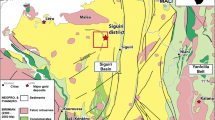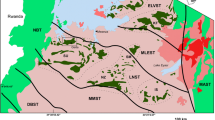Abstract
The El Espino IOCG mining district is characterized by several mineralized bodies the largest of which is the El Espino deposit, which has an estimated geologic resource of 123 Mt at 0.66 % Cu and 0.24 g/t Au. Mineralized bodies are distributed in a 7 × 10 km2 area throughout a 1,000-m vertical section. They range from single veins to stockworks and breccias to manto-type deposits. The ore bodies are hosted primarily by volcanic, volcaniclastic, and sedimentary rocks of the Early Cretaceous Arqueros and Quebrada Marquesa formations, with a few mineralized zones within Late Cretaceous dioritic intrusions. The fault and vein architecture shows that El Espino IOCG system was localized within a dilatational jog along a major transtensional dextral fault system. Sodic alteration (albite) is the most extensive style of alteration in the district, and it is bounded by major NS–NNE trending faults. Sodic–calcic (epidote–albite) alteration occurs at deep to medium elevations (1,000–500 m) and grades inward into calcic alteration. Calcic alteration surrounds dioritic intrusions of the Llahuin plutonic suite. Significant iron oxides are associated with later calcic alteration associations (actinolite–epidote–hematite). The upper portions of the alteration system (0–500 m) display hydrolytic alteration associations with abundant hematite. Hydrolytic veins are feeders to zones of manto-type alteration and mineralization within favorable volcano-sedimentary lithologies that formed El Espino deposit. Sulfides are largely confined to calcic and hydrolytic alteration associations. Hydrothermal fluids responsible for hematite and sulfide mineralization had salinities between 32 and 34 wt% NaCleq and temperature of approximately 425 °C at an estimated depth of 3–4 km. Geochronological U–Pb and 40Ar/39Ar data indicate that hydrothermal alteration was coeval with magmatic intrusive activity. One particular dioritic intrusion (88.5 Ma) preceded the calcic stage (88.4 Ma), which was accompanied by iron oxide copper and gold mineralization. Hydrolytic alteration, related to economic iron oxide copper and gold mineralization, came immediately after at 87.9 Ma.





















Similar content being viewed by others
References
Åberg G, Aguirre L, Levi B, Nyström JO (1984) Spreading-subsidence and generation of ensialic marginal basins: an example from Early Cretaceous of Central Chile. In: Kokellar BP, Howells MF (eds) Volcanic and associated sedimentary and tectonic processes in modern and ancient marginal basins, vol 16. Geological Society of London, Special Publication, London, pp 185–193
Aguirre L, Egert E (1965) Cuadrángulo Quebrada Marquesa, Provincia de Coquimbo, vol 15. Instituto de Investigaciones Geológicas, Carta Geológica de Chile, p 92
Allmendinger R, Marrett R, Cladouhos T (2001) FaultKin Version 1.2.2 (for Windows), computer program and user’s manual (for vol 1.1), 29 p. http://www.geo.cornell.edu/geology/faculty/RWA/programs.html
Arancibia G (2004) Mid-cretaceous crustal shortening: evidence from a regional-scale ductile shear zone in the coastal range of central Chile (32 degrees S). J S Am Earth Sci 17:209–226
Barton M, Johnson DA (1996) Evaporitic source model for igneous related Fe oxide-(REE–Cu–Au–U) mineralization. Geology 24:259–262
Barton M, Johnson D (2000) Alternative brine sources for Fe oxide (–Cu–Au) systems: implication for hydrothermal, alteration and metal. In: Porter TM (ed) hydrothermal iron-oxide cooper-gold and related deposits: A global perspective. Australian Mineral Foundation, Adelaide, pp 43–60
Benavides J, Kyser TK, Clark A, Oates C, Zamora R, Tarnovschi C, Castillo B (2007) The Mantoverde Iron-Oxide-Copper-Gold district, III Region, Chile: The role of regionally derived nonmagmatic fluids in chalcopyrite mineralization. Econ Geol 102:415–440
Campbell AR, Larson PB (1998) Introduction to stable isotope applications in hydrothermal systems. Rev Econ Geol 10:173–193
Chen H, Clark A, Kyser TK, Ullrich T, Baxter R, Chen Y, Moody T (2011) Evolution of the giant Marcona–Mina Justa iron oxide-copper-gold district. South-Central Peru Econ Geol 105:155–185
Chiaradia M, Banks D, Cliff R, Marschik R, de Haller A (2006) Origin of fluids in iron oxide–copper–gold deposits: constraints from delta Cl-37, Sr-87/Sr-86(i) and Cl/Br: Mineralium Deposita 41: 565–573
Correa A (2003) El Espino, un nuevo depósito del tipo Fe Cu (Au) en Chile. Comuna de Illapel, Region de Coquimbo. MS thesis, Universidad Catolica del Norte, Antofagasta, Chile, 69 pp
de Haller A (2006) The Raul-Condestable iron oxide copper–gold deposit, Central Coast of Peru. PhD thesis, Geneva, Switzerland, University of Geneva, Terre et Environment, vol 58, 123 p
de Haller A, Corfu F, Fontbote L, Barra F, Chiaradia M, Frank M, Zuniga Alvarado J (2006) Geology, geochronology, and Hf and Pb isotope data of the Raúl-Condestable iron oxide–copper–gold deposit, Central Coast of Peru. Econ Geol 101:281–310
Explorator Resources Report (2011) Preliminary Assesment on El Espino-Venus Property, Region IV, Chile. NI 43–101 Technical Report
Gana P, Zentilli M (2000) Historia termal y exhumación de intrusivos de la Cordillera de la Costa de Chile Central. Congreso Geológico Chileno IX, Puerto Varas, Chile, vol 2, pp. 664–668
Goldstein R, Reynolds T (1994) Systematics of fluid inclusions in diagenetic minerals: SEPM Short Course, 31 p
Groves D, Bierlein F, Meinert L, Hitzman M (2010) Iron oxide copper–gold (IOCG) deposits through Earth history: implications for origin, lithospheric setting, and distinction from other epigenetic iron oxide deposits. Econ Geol 105:641–654
Haynes DW (2000) Iron oxide copper (−gold) deposits: their position in the ore deposit spectrum and modes of origin. In: Potter TM (ed) Hydrothermal iron oxide copper–gold & related deposits: a global perspective. Australian Mineral Foundation, Adelaide, pp 71–90
Hitzman MW (2000) Iron oxide–Cu–Au deposits: what, where, when, and why. In: Porter TM (ed) Hydrothermal iron oxide–copper–gold and related deposits: a global perspective. Australian Mineral Foundation, Adelaide, pp 9–25
Levi B, Aguirre L (1981) Ensialic spreading-subsidence in the Mesozoic and Paleogene Andes of Central Chile. J Geol Soc Lond 138:75–81
Lopez G (2012) The El Espino iron oxide copper gold (IOCG) district, Coastal Cordillera of North-Central Chile, PhD thesis, Colorado School of Mines, 120 p
Marschik R, Fontbote L (2001) The Candelaria–Punta del Cobre iron oxide Cu–Au (–Zn–Ag) deposits. Chile Econ Geol 96:1799–1826
Morata D, Aguirre L (2003) Extensional lower cretaceous volcanism in the Coastal Range (29 degrees 20′–30 degrees S), Chile: geochemistry- and petrogenesis. J S Am Earth Sci 16:459–476
Mpodozis C, Ramos VA (1990) The Andes of Chile and Argentina In: Ericksen GE, Cañas Pinochet MT, Reinemud JA (eds) Geology of the Andes and its relation to hydrocarbon and mineral resources, Circumpacific Council for Energy and Mineral Resources, Earth Sciences Series, 11:59–90
Ohmoto H, Goldhaber M (1997) Sulfur and carbon isotopes. In: Barnes HD (ed) Geochemistry of hydrothermal ore deposits (3rd edn). Wiley, New York, pp 517–612
Ohmoto H, Rye RO (1979) Isotopes of sulfur and carbon. In: Barnes HL (ed) Geochemistry of hydrothermal ore deposits. Wiley, New York, pp 509–567
Parada MA, Nystrom J, Levi B (1999) Multiple sources for the Coastal Batholith of central Chile (31–34 degrees S): geochemical and Sr–Nd isotopic evidence and tectonic implications. Lithos 46:505–521
Parada MA, Féraud G, Fuentes F, Aguirre L, Morata D, Larrondo P (2005) Ages and cooling history of the Early Cretaceous Caleu pluton: testimony of a switch from a rifted to a compressional continental margin in central Chile. J Geol Soc Lond 162:273–287
Pollard PJ (2006) An intrusion-related origin for Cu–Au mineralization in iron oxide–copper–gold (IOCG) provinces. Miner Deposita 41:179–187
Rieger AA, Marschik R, Diaz M, Hölzl S, Chiaradia M, Akker B, Spangenberg J (2010) The hypogene iron oxide copper–gold mineralization in the Mantoverde district. North Chile Econ Geol 105:1271–1299
Rieger A, Marschik R, Diaz D (2012) The evolution of the hydrothermal IOCG system in the Mantoverde district, northern Chile: new evidence from microthermometry and stable isotope geochemistry. Miner Deposita 47:359–369
Rivano S, Sepulveda H (1991) Hoja Illapel, Region de Coquimbo In: Mpodozis C (ed) Carta Geologica de Chile, scale 1:250,000
Sillitoe RM (2003) Iron oxide–copper–gold deposits: an Andean view. Miner Deposita 38:787–812
Tatsumi Y, Eggins S (1995) Subduction zone magmatism. Blackwell Science, Boston, p 211
Vergara M, Levi B, Nystrom J, Cancino A (1995) Jurassic and Early Cretaceous island arc volcanism, extension and subsidence in the coast range of Central Chile. Geol Soc Am Bull 107:1427–1440
Williams PJ, Barton MD, Johnson DA, Fontboté L, de Haller A, Mark G, Oliver, NHS, Marschik R (2005) Iron oxide copper–gold deposits: geology, space–time distribution, and possible modes of origin: Economic Geology 100th Anniversary Volume, pp. 371–405
Wilson M (1992) Magmatism and continental rifting during the opening of the South Atlantic Ocean: a consequence of Lower Cretaceous Superplume activity? In: Storey B, Alabaster T, Pankhurst R (eds) Magmatism and the causes of continental break-up. Geol Soc Spec Pub 68: 241–255
Acknowledgements
This work was supported by the National Science Foundation project EAR-0207217. Assistance from Teckcominco for field work logistics and chemical rock analysis and assistance from John Humphrey and Jim Reynolds (Fluidinc) on the sulfur isotope and fluid inclusion studies, respectively, are gratefully acknowledged. GPL also acknowledges invaluable help from the Society of Economic Geologists through Terrones and McKinstry student research grants, from a Newcrest Resources Economic Geology Fellowship, and from Sarah Gleeson (University of Alberta) for discussions and access to facilities.
Author information
Authors and Affiliations
Corresponding author
Additional information
Editorial handling: R. P. Xavier
Rights and permissions
About this article
Cite this article
Lopez, G.P., Hitzman, M.W. & Nelson, E.P. Alteration patterns and structural controls of the El Espino IOCG mining district, Chile. Miner Deposita 49, 235–259 (2014). https://doi.org/10.1007/s00126-013-0485-0
Received:
Accepted:
Published:
Issue Date:
DOI: https://doi.org/10.1007/s00126-013-0485-0




